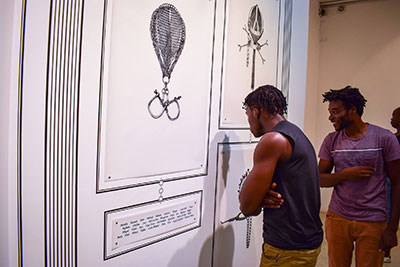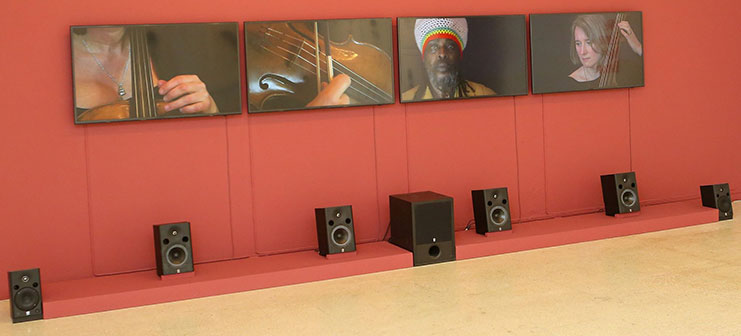FOLLOWING an ongoing dialogue between Scottish artist Graham Fagen and Lucy Byatt (of the Hospitalfield artist residency programme in Arbroath, Scotland) about possibly showing Fagen’s project `The Slave’s Lament ‘ in Jamaica, the idea for a collaborative initiative between the National Gallery of Jamaica and the British Council began to take root.
That dialogue, which began at last year’s Tilting Axis II conference in Miami, became the catalyst that prompted `We Have Met Before’, an exhibition of works featuring Fagen and three other artists: Joscelyn Gardner (Barbados and Canada), Ingrid Pollard (Guyana and England) and Leasho Johnson (Jamaica).

Since one of the more profound connections in each artist’s work is their use of historical material to work through the implications of the many traumas linked to the Trans-Atlantic Slave Trade, it was recognised almost immediately that the statement of Fagen’s work would be amplified with the inclusion of the local perspectives these artists could provide.
This exhibition, therefore, positions the works of these four artists in a way that engages with the difficult subject of Trans-Atlantic slavery, as part of an ongoing conversation that allows for multiple perspectives on the shared histories of slavery between the Caribbean and Europe. While modern and contemporary engagement with this subject is hardly new, this exhibition presents an opportunity to redress the dismissal of slavery’s role in the shaping of both regions.
Fagen’s video and sound installation `The Slave’s Lament’ is based on a 1792 song written by Scotland’s national poet Robert Burns, in which an enslaved man in Virginia longs for his distant homeland of Senegal. In Fagen’s interpretation, the song is performed by the Rastafarian reggae singer, Ghetto Priest, and acknowledges Scottish involvement in slavery in the Americas. While their involvement may be well known in the Caribbean it still remains part of the unacknowledged history of Scotland.

Johnson presents a visually and conceptually explosive mix of history and contemporary popular culture, with strong references to dancehall music and graffiti art. His use of cartoon-like female and gender-ambivalent figures in various provocative poses reference the politics of sexual objectification, the contradictions of gender and sexuality in contemporary Jamaican culture and the violent histories of the Caribbean archipelago. In addition to highlighting the histories of colonisation and multiple systems of oppression as root causes of these issues, Johnson’s work also acknowledges their revolutionary, counter-hegemonic potential in the present.
Pollard’s `The Boy Who Watches Ships Go By (2002)’ includes photographic images of land, sea, boats and historical documents that subtly evoke the histories, visible and invisible, of Sunderland Point in northern England. The once thriving seaport in the Triangular Trade is the setting for the story of Sambo, a young boy presumed to be an enslaved servant who travelled with the captain of the Globe from Kingston, Jamaica, to England.

He fell ill and died shortly after his arrival, sparking the belief that his death was the result of a disease he contracted in England to which he had no immunity. Pollard presents Sambo’s story and the physical site of his burial as a metaphor for the fate of those who lost their lives and freedom, as a result of their contact with European slave traders.

Gardner’s exhibits include two series of lithographs – Plantation Poker (2004), Creole Portraits II (2007) and a selection of lithographs from the Creole Portraits III (2009-2011) series. Although these prints subscribe to similar conventions of natural history illustrations, the intricate African braided hairstyles morph into much darker torture instruments that were used during slavery.
A more specific reference to sexual abuse is added in the imagery in Plantation Poker, where the triangular shape of the hair references female pubic hair, while the flowers in Creole Portraits III reference plants used by enslaved women to secretly induce miscarriage. There is a duality present in the way Gardner’s works are deceptively delicate but also invoke the brutality of plantation slavery.

The We Have Met Before exhibition was conceptualised to mark a new way of collaborating between cultural institutions in the region, where those involved become partners working together on the ground to develop projects that make room for conversations about these issues to thrive. According to the organisers, this exhibition will be reconfigured to include Bahamian artists whose works will engage with Fagen’s project, when it eventually moves to the National Art Gallery of the Bahamas.
`We Have Met Before’ continues until November 4 at the National Gallery of Jamaica.




.png)









